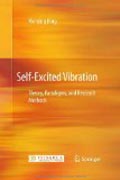
Based on a systematic understanding of its theoretical foundations, “Self-Excited Vibration: Theory, Paradigms, and Research Methods” offers a method for analyzing any type of self-excited vibration (SEV). After summarizing the research results of various SEV phenomenon, including chatter, shimmy, rotor whirl,flutter, gallop, and SEV of man-made control systems, the author constructs ageneral constitutive mechanism of SEV, as well as a common research program and detailed analysis technique. All of these will help the reader independently analyze any new SEV phenomena. . Prof. Wenjing Ding was the Director of the Dynamics and Vibration Division of the Engineering Mechanics Department of Tsinghua University, China. Probes into the general constitutive mechanisms of a variety of self-exited vibrations (SEV). Emphasizes building a systematic SEV theory. Helps readerscompletely master the techniques needed to study SEV phenomena. INDICE: Introduction. Geometrical Method. Stability Methods. Quantitative Methods. Analysis Method for Closed-Loop System. Stick-Slip Vibration. DynamicShimmy of Front Wheel. Rotor Whirl. Self-Excited Vibrations from Interaction of Structures and Fluid. Self-Excited Oscillations in Feedback Control System.Modeling and Control.
- ISBN: 978-3-540-69740-4
- Editorial: Springer Berlin Heidelberg
- Encuadernacion: Cartoné
- Páginas: 275
- Fecha Publicación: 31/05/2011
- Nº Volúmenes: 1
- Idioma: Inglés
